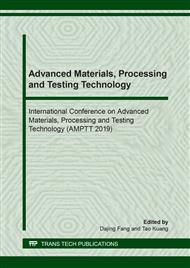[1]
Montagnier O, Hochard C. Optimisation of hybrid high-modulus/high-strength carbon fibre reinforced plastic composite drive shafts. Materials & Design, 2012; 46(4): 88-100.
DOI: 10.1016/j.matdes.2012.09.035
Google Scholar
[2]
Ding G, Xie C, Zhang J, et al. Modal analysis based on finite element method and experimental validation on carbon fibre composite drive shaft considering steel joints. Material Research Innovations, 2015, 19(S5): S5-748-S5-753.
DOI: 10.1179/1432891714z.0000000001187
Google Scholar
[3]
Shokrieh MM, Hasani A, Lessard LB. Shear buckling of a composite drive shaft under torsion. Compos. Struct. 2004; 64: 63–69.
DOI: 10.1016/s0263-8223(03)00214-9
Google Scholar
[4]
Khalid YA, Mutasher SA, Sahari BB, et al. Bending fatigue behavior of hybrid aluminum/composite drive shafts. Mater. Des. 2007; 28: 329–334.
DOI: 10.1016/j.matdes.2005.05.021
Google Scholar
[5]
Mutasher SA. Prediction of the torsional strength of the hybrid aluminum/composite drive shaft. Mater. Des. 2009; 30: 215–220.
DOI: 10.1016/j.matdes.2008.05.024
Google Scholar
[6]
Srinivasa Moorthy R, Mitiku Y, Sridhar K. Design of automobile driveshaft using carbon/epoxy and kevlar/epoxy composites. Am. J. Eng. Res. 2013; 2: 173–179.
Google Scholar
[7]
Cherniaev A, Komarov V. Multistep optimization of composite drive shaft subject to strength, buckling, vibration and manufacturing constraints. Appl. Compos. Mater. 2015; 22: 475–487.
DOI: 10.1007/s10443-014-9418-z
Google Scholar
[8]
Montagnier O, Hochard C. Optimisation of hybrid high-modulus/high-strength carbon fibre reinforced plastic composite drive shafts. Mater. Des. 2013; 46: 88–100.
DOI: 10.1016/j.matdes.2012.09.035
Google Scholar
[9]
Khalkhali A, Nikghalb E, Norouzian M. Multi-objective optimization of hybrid carbon/glass fiber reinforced epoxy composite automotive drive shaft. Int. J. Eng. 2015; 28: 583–592.
DOI: 10.5829/idosi.ije.2015.28.04a.13
Google Scholar
[10]
Badie M A, Mahdi E, Hamouda A M S. An investigation into hybrid carbon/glass fiber reinforced epoxy composite automotive drive shaft. Mater. Des. 2011; 32(3): 1485-1500.
DOI: 10.1016/j.matdes.2010.08.042
Google Scholar
[11]
Shadmehri F, Derisi B, Hoa S V. On bending stiffness of composite tubes. Composite Structures. 2011; 93(9): 2173-2179.
DOI: 10.1016/j.compstruct.2011.03.002
Google Scholar
[12]
Menshykova M, Guz I A. Stress analysis of layered thick-walled composite pipes subjected to bending loading. International Journal of Mechanical Sciences. 2014; 88: 289-299.
DOI: 10.1016/j.ijmecsci.2014.05.012
Google Scholar
[13]
Sun X S, Tan V B C, Chen Y, et al. Stress analysis of multi-layered hollow anisotropic composite cylindrical structures using the homogenization method. Acta Mechanica. 2014; 225(6): 1649-1672.
DOI: 10.1007/s00707-013-1017-9
Google Scholar
[14]
Yazdani H, Hoa S V, Hojjati M. Effects of Shear Loading on Stress Distributions at Sections in Thick Composite Tubes. Composite Structures. 2016; 140: 433-445.
DOI: 10.1016/j.compstruct.2015.12.067
Google Scholar
[15]
Hu Y, Yang M, Zhang J, et al. Effect of stacking sequence on the torsional stiffness of the composite drive shaft. Advanced Composite Materials, 2016: 1-16.
DOI: 10.1080/09243046.2016.1207126
Google Scholar
[16]
Oh J H. Nonlinear analysis of adhesively bonded tubular single-lap joints for composites in torsion. Composites Science & Technology, 2007, 67(7): 1320-1329.
DOI: 10.1016/j.compscitech.2006.09.020
Google Scholar
[17]
Natsuki T, Takayanagi H, Tsuda H, et al. Prediction of Bending Strength for Filament-Wound Composite Pipes. Journal of Reinforced Plastics & Composites. 2003; 22(8): 695-710.
DOI: 10.1177/0731684403022008002
Google Scholar
[18]
Ijsselmuiden S T, Abdalla M M, Seresta O, et al. Multi-step blended stacking sequence design of panel assemblies with buckling constraints. Composites Part B Engineering. 2009; 40(4): 329-336.
DOI: 10.1016/j.compositesb.2008.12.002
Google Scholar
[19]
Oh J H. Nonlinear analysis of adhesively bonded tubular single-lap joints for composites in torsion. Composites Science & Technology. 2007; 67(7): 1320-1329.
DOI: 10.1016/j.compscitech.2006.09.020
Google Scholar


